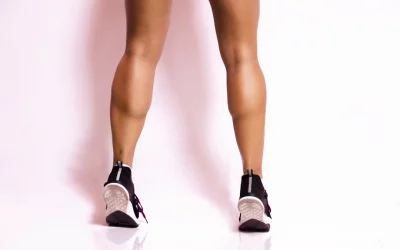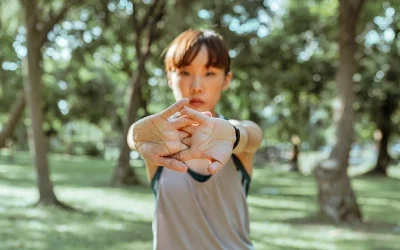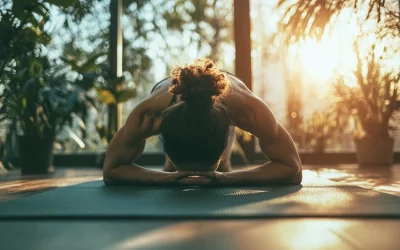Have you been dealing with persistent pain between your shoulder blades? Chances are it’s your rhomboid muscles staging a revolution of their own. Poor posture, repetitive moments, and strain from lifting are the usual suspects behind rhomboid pain. Luckily, targeted stretches can help relieve this tension.
In this article, we break down some of the best stretches to ease rhomboid pain and bring comfort back into your daily routine.
How Rhomboid Pain Affects Your Daily Life
Rhomboid pain, also known as interscapular pain, can significantly disrupt your daily life by affecting basic activities you often take for granted. One immediate impact is poor posture. When the rhomboid muscles are tense or strained, it becomes difficult to sit or stand comfortably for long periods. This can lead to slouching or awkward positions, which only worsen discomfort over time.
In addition to posture issues, you might find simple movements more painful and restricted. Tasks like reaching overhead to grab something from a shelf or lifting even lightweight objects become challenging. The limited mobility in the shoulder area forces you to alter how you perform everyday actions, often resulting in additional strain on the body.
Breathing can also become uncomfortable, especially when taking deep breaths. Because the rhomboid muscles are located near the ribcage, tension in this area can cause sharp or dull pain during inhalation, making it harder to breathe normally. This can be particularly noticeable during physical activities or even when lying down.
Effective Rhomboid Pain Stretch Techniques
Child’s Pose with Shoulder Blade Stretch
Child’s Pose is a simple yet highly effective stretch for targeting tension in your rhomboid muscles.
To start, kneel on the floor with your big toes touching and your knees spread apart. Slowly lower your torso between your thighs, extending your arms forward. Rest your forehead on the floor, and ensure your hips are sinking back towards your heels. This alignment is important for creating space between your shoulder blades, which helps stretch the rhomboids.
Once in position, focus on engaging your shoulder blades. Actively reach your arms forward while drawing your shoulder blades down and toward each other. This motion deepens the stretch in your upper back, specifically targeting the rhomboid muscles, and helps release tightness.
To improve the stretch further, practice slow, controlled breathing. As you inhale, imagine sending breath into your upper back, allowing your ribcage to expand. On every exhale, sink deeper into the pose, feeling the tension melt away from the rhomboid area.
Reverse Doorway Stretch
The Reverse Doorway Stretch is an easy and very potent technique for focusing on your rhomboid muscles and reducing tension.
To set up, stand in a doorway and grip both sides of the frame at about shoulder height. Make sure your feet are positioned slightly in front of you so that your body can lean back comfortably.
You can customize the stretch by adjusting your grip width. A wider grip will engage your rhomboids and surrounding muscles more intensely, while a narrower grip might feel more manageable for beginners or those with tight shoulders. Experiment with different positions to find what feels best for you.
Once you’re in position, lean your body back to deepen the stretch. This movement pulls your shoulder blades together, directly engaging the rhomboid muscles. Be sure to move slowly and with control, as overstretching can lead to discomfort or injury. Aim to feel a gentle pull, instead of pain.
Eagle Arms Stretch
The Eagle Arms Stretch offers a straightforward yet powerful way to target your rhomboid muscles and ease tension in the upper back.
To start, sit or stand comfortably with your spine tall and shoulders relaxed. Extend both arms forward at shoulder height, then cross your right arm over your left, bringing your elbows to touch.
Next, bend your elbows, wrapping your forearms so that your palms come together or as close as possible. If your palms don’t meet, you can place the back of your hands together instead. The key is to feel a gentle stretch across your upper back.
Once in position, lift your elbows slightly and reach your fingertips forward, creating space between your shoulder blades. This movement specifically engages the rhomboid muscles, helping to alleviate tightness. For added benefit, gently press your forearms forward as you inhale deeply, expanding through the upper back, and on each exhale, relax further into the stretch.
Hold this position for up to 30 seconds to allow a deep, effective stretch. For a gentler option, beginners can hold the stretch for 10 seconds, repeating it three times for similar benefits. When finished, release your arms slowly and switch sides, crossing your left arm over your right. This balanced approach helps relieve tension evenly across both rhomboid muscles.
Thread the Needle
The “Thread the Needle” stretch provides a gentle but impactful release for tight rhomboid muscles. This stretch helps you target the middle and upper back, offering relief from tightness in the shoulders and between the shoulder blades.
To start, come onto all fours, with your hands aligned under your shoulders and your knees directly beneath your hips. Keeping your back flat, slowly slide your right arm under your left arm, palm facing up, and lower your right shoulder toward the ground. Rest the side of your head on the floor and feel the stretch across your upper back and rhomboids. Make sure your hips remain squared to the floor to maintain proper alignment.
For a deeper stretch, you can experiment with different arm positions. After threading your arm under, you can walk your left hand forward or even extend it straight up toward the ceiling. These variations increase the stretch across the rhomboid area and other muscles in the upper back.
If you want to further alleviate tension, gently turn your head so that your gaze follows your extended arm. This adds a neck stretch, helping to relieve additional tightness in your upper back and shoulders.
Hold the position for up to 30 seconds. Beginners can start by holding the stretch for 10 seconds and repeating it three times for similar benefits. When finished, switch sides to balance the stretch across both rhomboid muscles.
Additional Tips for Rhomboid Pain Relief
To complement your stretching routine and further reduce rhomboid pain, there are a few additional strategies you can try. These techniques can help ease discomfort and promote healing, especially when used alongside regular stretches.
One effective way to manage discomfort is to apply heat or ice to the affected area. Heat works well to loosen tight muscles, making it easier to stretch and move without pain. On the other hand, ice can reduce inflammation, especially if you’re dealing with swelling or an acute injury. Depending on your preference or the stage of your pain, choose the method that feels best.
While stretching is key to relief, avoid overstretching. Pushing too hard can strain the rhomboid muscles further, worsening your pain. Instead, ease into each stretch and pay close attention to how your body responds. If you feel discomfort beyond mild tension, back off. To ensure proper form and avoid pushing your muscles too far, you can use visual guidance provided by stretching apps like WeStretch to know the right movements for each stretch.
“For long-term relief, I’d say practice regularly. Doing these stretches consistently really helps maintain flexibility and muscle strength, which can prevent that tension from building up again. But it’s also essential to listen to your body. If you’re feeling sore or fatigued, adjust the intensity or frequency of your exercises. Remember this: Regularity is key, but knowing when to rest is just as important.”
Exercise Smarter with WeStretch: Your All-in-One Stretching Assistant
![]() A consistent full-body stretching routine is essential for improving flexibility, supporting injury prevention, and enhancing overall well-being. Carefully following simple yet effective stretches targeting the hamstrings, hip flexors, back, quads, chest, and shoulders, individuals of any fitness level can reap the benefits.
A consistent full-body stretching routine is essential for improving flexibility, supporting injury prevention, and enhancing overall well-being. Carefully following simple yet effective stretches targeting the hamstrings, hip flexors, back, quads, chest, and shoulders, individuals of any fitness level can reap the benefits.
Regular stretching, with attention to proper form and consistency, can help you move more freely, recover faster, and feel better in everyday activities.
Looking for a way to add some fun to your stretching routine? Check out WeStretch—an app that’s like your own personal stretch coach! With tailored plans, easy-to-follow demos, and progress tracking, it’s got everything you need to keep you limber and on point. Ready to get flexible? Sign up today and let’s get stretching!
FAQ
How do you release rhomboid pain?
Focus on targeted stretches and exercises that improve flexibility and reduce tension. Try shoulder blade squeezes, where you pull your shoulder blades together, or the seated twist, which gently stretches the upper back. Wall angels and thread-the-needle stretches can also help relieve tightness. Incorporating deep breathing and focusing on posture will further aid in relieving discomfort.
How do you loosen a tight rhomboid?
Try stretches like the eagle arms stretch or a seated twist. You can also perform foam rolling to massage the area. Strengthening exercises such as rows or scapular retractions can help balance muscles and prevent future tightness. Don’t forget to incorporate deep breathing to promote relaxation and improve your range of motion.
What does a tight rhomboid feel like?
A tight rhomboid often feels like a sharp or aching pain between the shoulder blades, sometimes radiating to the neck or shoulders. It might also cause stiffness, restricted movement, or a sensation of muscle knots. The discomfort is typically aggravated by activities like lifting, pulling, or prolonged sitting.
How should you sleep with rhomboid pain?
Try lying on your back with a pillow supporting your upper back and another under your knees to reduce strain. Side sleepers can place a pillow between their arms to maintain spinal alignment and avoid pressure on the rhomboids. Avoid sleeping on your stomach, as it can increase tension in the area.
What causes rhomboid pain?
Rhomboid pain is often caused by muscle strain, poor posture, repetitive motions, or prolonged sitting. Activities like lifting, rowing, or slouching at a desk can overwork the rhomboid muscles, leading to tightness and discomfort. Stress and improper exercise form can also contribute to tension in this area.






